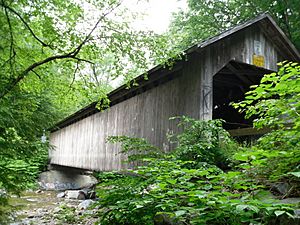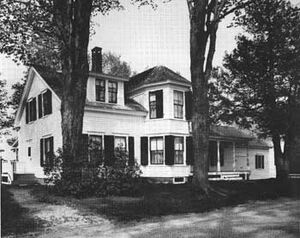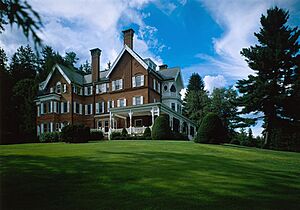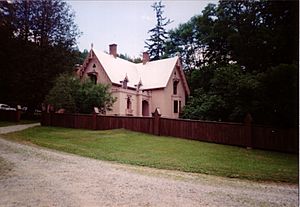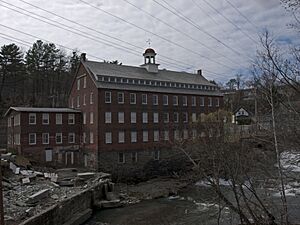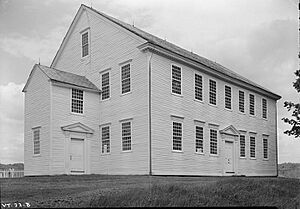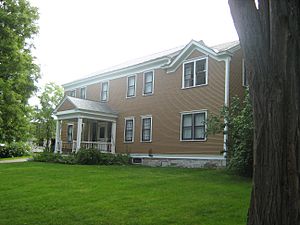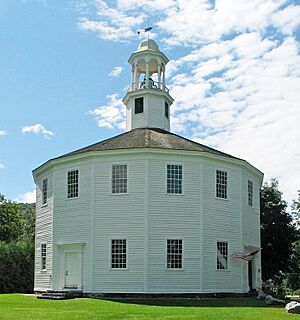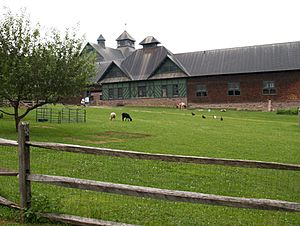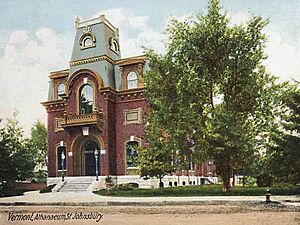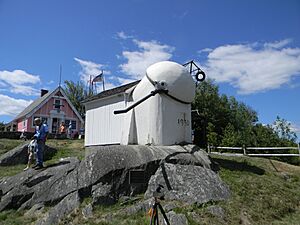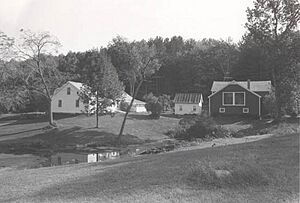List of National Historic Landmarks in Vermont facts for kids
Vermont is a beautiful state with a rich history! It's home to many special places called National Historic Landmarks. These are buildings, sites, or objects that are super important to the history of the United States. They are recognized by the U.S. government for their unique stories and what they teach us about the past. Vermont has 18 of these amazing landmarks. Let's explore some of them!
Contents
- Vermont's Historic Treasures
- Brown Covered Bridge
- Calvin Coolidge Homestead District
- Robert Frost Farm (Ripton)
- George Perkins Marsh Boyhood Home
- Justin Smith Morrill Homestead
- Mount Independence
- Naulakha (Rudyard Kipling House)
- Robbins and Lawrence Armory and Machine Shop
- Rockingham Meeting House
- Rokeby (Ferrisburg)
- Round Church (Richmond)
- Shelburne Farms
- St. Johnsbury Athenaeum
- Socialist Labor Party Hall
- Stellafane Observatory
- Ticonderoga (Steamboat)
- Vermont State House
- Emma Willard House
- Former Landmark
- See also
Vermont's Historic Treasures
Brown Covered Bridge
The Brown Covered Bridge is a beautiful old wooden bridge built in 1880. It's located in Shrewsbury, in Rutland County. This bridge is a fantastic example of a "Town lattice truss" design, which was a special way to build strong wooden bridges. It might even be the last bridge built by a famous bridge builder named Nichols Powers!
Calvin Coolidge Homestead District
In Plymouth Notch, Windsor County, you can find the Calvin Coolidge Homestead District. This is the birthplace and family home of Calvin Coolidge, who became the 30th President of the United States. It was recognized as a landmark in 1965.
Robert Frost Farm (Ripton)
The Robert Frost Farm is in Ripton, Addison County. This was the home of the famous American poet Robert Frost. He wrote many of his well-known poems here. Today, Middlebury College owns and cares for this special place. It became a landmark in 1968.
George Perkins Marsh Boyhood Home
Located in Woodstock, Windsor County, this was the childhood home of George Perkins Marsh. He was an important American diplomat and scholar, and one of the very first environmentalists! His ideas helped people understand the importance of protecting nature. This home is now part of the Marsh-Billings-Rockefeller National Historical Park. It was listed as a landmark in 1967.
Justin Smith Morrill Homestead
The Justin Smith Morrill Homestead is in Strafford, Orange County. This beautiful home, built in the Gothic Revival style, belonged to Justin Smith Morrill. He was a Vermont representative and senator. He's famous for creating the Morrill Land-Grant Colleges Acts in 1862 and 1890, which helped establish many public universities across the country. This homestead became a landmark in 1960.
Mount Independence
In Orwell, Addison County, you'll find Mount Independence. This was the site of Fort Independence, a very important fort built during the American Revolutionary War. It was built right across from Fort Ticonderoga and played a key role in protecting the area. It was designated a landmark in 1972.
Naulakha (Rudyard Kipling House)
Naulakha is located in Dummerston, Windham County. This was the home where the famous author Rudyard Kipling wrote his classic book, The Jungle Book! It became a landmark in 1993.
Robbins and Lawrence Armory and Machine Shop
In Windsor, Windsor County, stands the Robbins and Lawrence Armory and Machine Shop. Built in 1846, this building is an excellent example of how factories looked and worked in the 1800s. It shows us a lot about early American industry. It was listed as a landmark in 1966.
Rockingham Meeting House
The Rockingham Meeting House is in Rockingham, Windham County. This building is a rare and well-preserved example of an 18th-century New England meetinghouse. These meetinghouses were important places for both religious services and town meetings. It became a landmark in 2000.
Rokeby (Ferrisburg)
Rokeby is a historic farm in Ferrisburg, Addison County. This farm, owned by the Robinson family, is very important because of its role in the Underground Railroad. The Underground Railroad was a secret network that helped enslaved people escape to freedom. Rokeby was recognized as a landmark in 1997.
Round Church (Richmond)
The Round Church is in Richmond, Chittenden County. Built between 1812 and 1813, this church is a rare and well-preserved example of a sixteen-sided meetinghouse. Its unique shape makes it stand out! It became a landmark in 1996.
Shelburne Farms
Shelburne Farms is a large and beautiful estate in Shelburne, Chittenden County. It was created in 1886 by Dr. William Seward Webb and Eliza Vanderbilt Webb. They designed it as a "model agricultural estate," meaning it was a perfect example of how a farm could be run. It was designated a landmark in 2001.
St. Johnsbury Athenaeum
The St. Johnsbury Athenaeum is in St. Johnsbury, Caledonia County. This building is important for its amazing architecture, its collection of American paintings, and its original role as a public library and free art gallery. It was funded by Horace Fairbanks, who invented the world's first platform scale! It became a landmark in 1996.
Socialist Labor Party Hall
The Socialist Labor Party Hall is in Barre, Washington County. This hall was an important place where people debated and discussed ideas about socialism, anarchism, and labor politics. It shows a part of America's history of political thought and worker's rights. It was recognized as a landmark in 2000.
Stellafane Observatory
The Stellafane Observatory is located in North Springfield, Windsor County. This site includes the original clubhouse of the Springfield Telescope Makers, Inc., built in 1924. It also has the first large optical telescope (from 1930) that was built and owned by an amateur astronomy group. It's a special place for people who love looking at the stars! It became a landmark in 1989.
Ticonderoga (Steamboat)
The Ticonderoga is a 220-foot long steamboat built in Shelburne in 1906. It's located in Shelburne, Chittenden County. This side-paddle-wheel lakeboat is a great example of early 20th-century transportation on Lake Champlain. It was designated a landmark in 1964.
Vermont State House
The Vermont State House is in Montpelier, Washington County. This beautiful building is the capitol of Vermont and where the state's laws are made. It's a symbol of Vermont's government and history. It became a landmark in 1970.
Emma Willard House
The Emma Willard House is in Middlebury, Addison County. This was the home of Emma Willard, a very important person who helped create and improve education for girls and women in the United States. She was a true pioneer! Her home was recognized as a landmark in 1965.
Former Landmark
Sometimes, a landmark might lose its special status if it changes too much.
Robert Frost Farm, "The Gully" (South Shaftsbury)
This property in South Shaftsbury, Bennington County, was also a home of poet Robert Frost between 1929 and 1938. Many of his famous poems were written here. It was named a landmark in 1968. However, after 1979, the buildings were changed a lot. Because of these big changes, the Park Service decided to remove its landmark status in 1986.
See also


